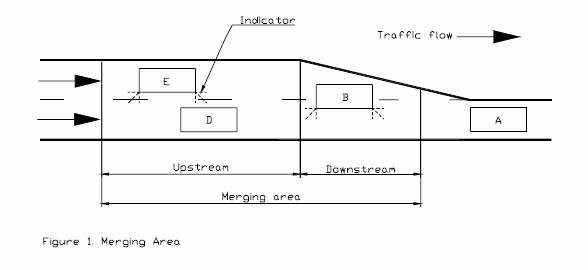When two or more upstream lanes are connected to a single downstream lane, a merging area is defined. In the merging area, additional caution is required on the part of motorists because vehicles from the two lanes may need to co-ordinate with each other. Merging is classified into (1) priority merging and (ii) non-priority merging. Priority merging includes merging from minor streets to major streets. Non-priority merging typically occurs at the downstream of toll plazas and lane drops on freeways.
Non-Priority Merge lanes (Zipper Merge)
For Non-Priority merge lanes two or more lanes come together (aka a lane drop) with no stop or give way designation for either lane. Merging is carried out on a “first come -first go” basis. This type of merge is commonly referred to as a 'zipper merge' in some jurisdictions. Zipper Merges create a high potential for side swipes and rear end accidents thus careful communication and knowledge of merging practices is essential.
Priority Merge Lanes
For Priority merge lanes, a vehicle without the right of way must check whether there is any vehicle from the competing upstream lane. The vehicle executes the merge only if the projected headway gap is acceptable. If there is no acceptable gap, the vehicle must treat the vehicle, which has the right of way as the leader, and prepare to merge in behind that vehicle as it passes. If there is no clearance in which to execute this manoeuvre the vehicle must come to a stop at the end of the lane until it is clear to merge.
Merging Area
A merging area consists of an upstream area (e.g. 300ft) and downstream area (e.g. 200 ft). An upstream merging area vehicle (i.e. vehicle E) is tagged as a merging vehicle. Vehicle B in figure 1 is shown making an acceptable merge manoeuvre in the downstream area. Vehicles are no longer considered as merging once they leave the merge area (as with vehicle A)
Congestion Merging
Heavy or congested traffic flow causes a breakdown in merge lane operations. For optimal traffic flow during heavy congestion periods all merging should take place in the downstream area (at the end of the merge lane). Attempting to merge too far upstream during congestion periods is not advisable as it only adds to congestion and increases driver confusion and frustration.

